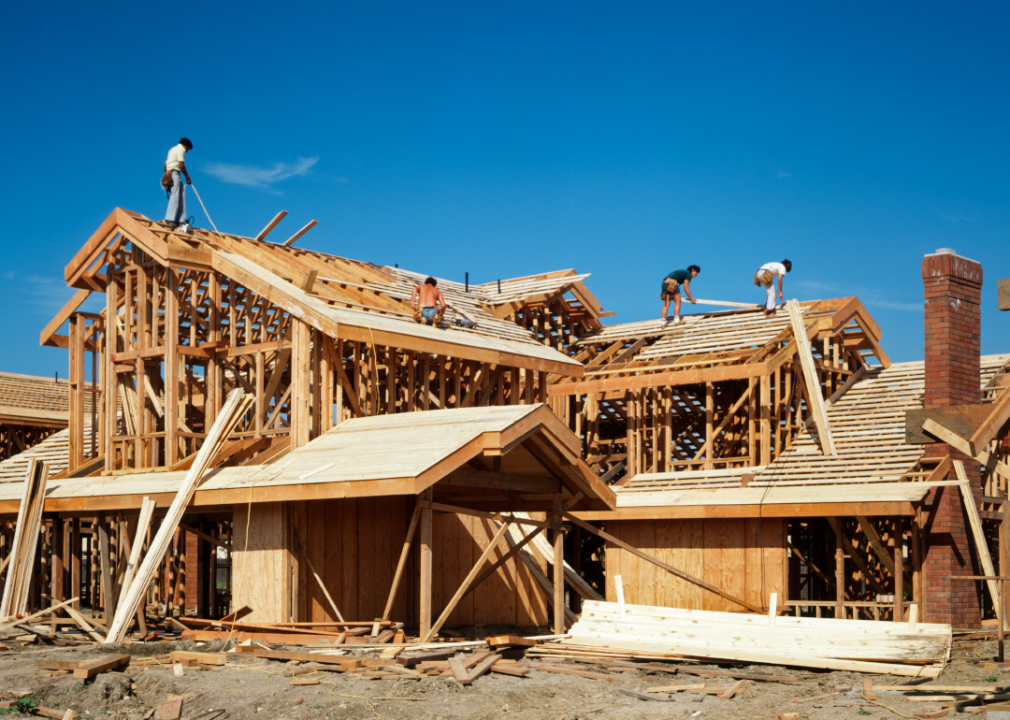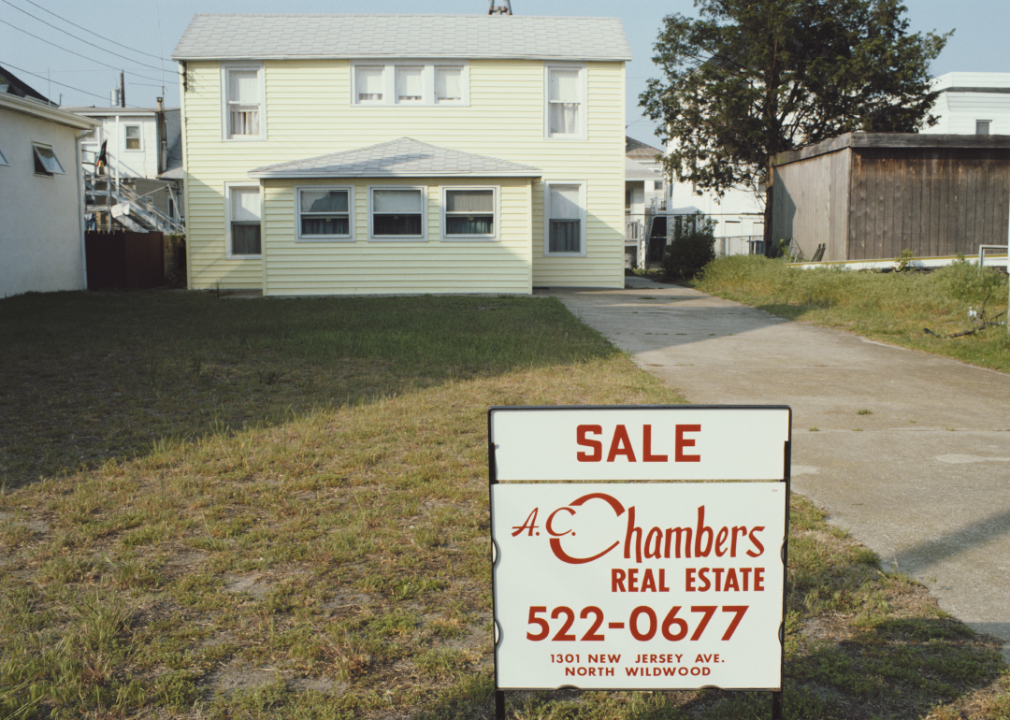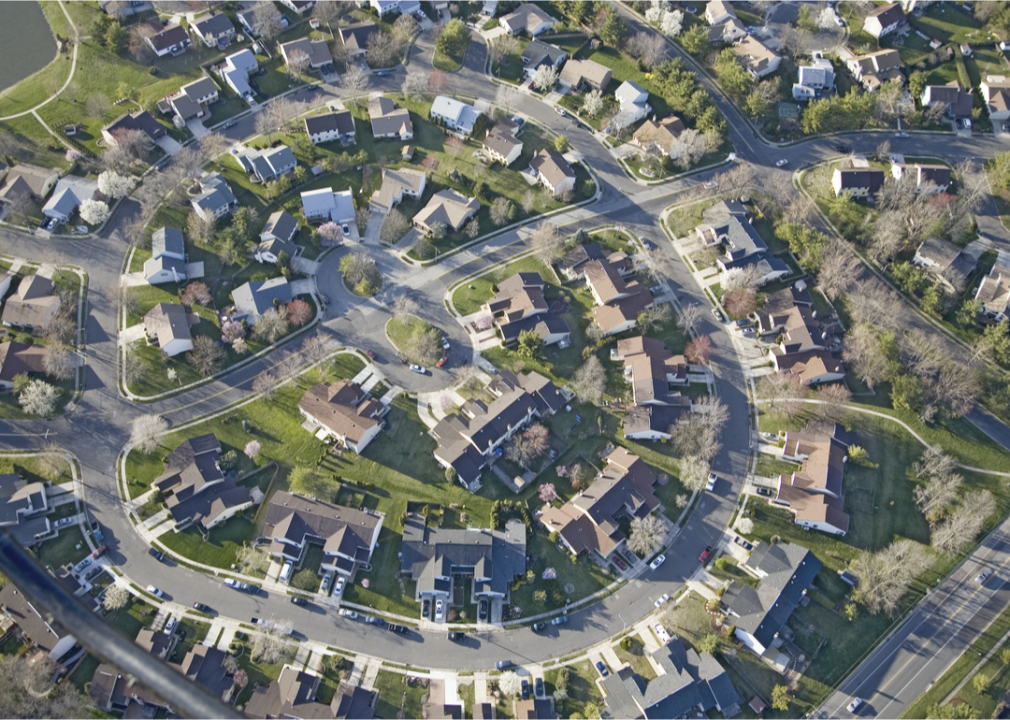Stay-at-home orders during the pandemic have forced many to rethink their living situation. Small apartments have stopped being cozy and are feeling too cramped to quarantine for months on end, driving some 22% of U.S. adults to relocate, or at least know someone else who has, according to the Pew Research Center.
What’s more, the COVID-19 crisis made many people realize they wanted more control over the place they lived — so larger numbers of Americans pursued homeownership. Data from the Census Bureau shows that the homeownership rate climbed to 67.9% in the second quarter of 2020, a whopping four percentage-point boost from where things stood a year earlier. The rates of homeownership in the United States are now poised to rival what was seen before the subprime mortgage crisis of 2007.
And taking a look at what the housing market has done over the past 50 years can give potential homebuyers a deeper understanding of what may come. Thinking of buying your first home and ditching the renters life for good? Click through to learn more about how real estate, mortgages, and homeownership have changed throughout the last five decades.
1971 – 1975
- Inflation-adjusted average home sales price: $ 177,412 (+1% compared to previous year)
- Housing starts: 1.2 – 2.4 million units
- Homeownership rate: 64%
Freddie Mac began keeping track of 30-year fixed-rate mortgage rates in 1971. The data would help give policymakers, economists, and everyday Americans a deeper understanding of the housing market. A year later, housing starts, an economic indicator that tracks the start of construction on new privately owned homes, hit a record high. Construction began on some 2.4 million homes that year, according to the Federal Reserve Bank of St. Louis.

President Richard Nixon announced a temporary end to approvals of subsidized housing programs beginning in January 1973. The moratorium lasted until mid-1974. That same year, Congress passed the Equal Credit Opportunity Act, which helped open up home financing opportunities to more people.
The law prevents creditors from discriminating against potential borrowers based on protected qualities such as their race, religion, sex, age, or marital status. Another form of aid came in 1975, known as the Emergency Homeowners’ Relief Act, which allowed Housing and Urban Development to make mortgage relief payments for homeowners experiencing financial distress. It was aimed at fending off widespread mortgage defaults during an adverse time in the economy.
1976
- Inflation-adjusted average home sales price: $ 215,929 (+6.8% compared to previous year)
- Housing starts: 1.5 million units (+32.4% compared to previous year)
- Homeownership rate: 64.7%
- Housing price-to-rent ratio: 1.07x
According to The New York Times, the early 1970s battered the residential construction industry in the United States. Things began turning around between 1975 and 1976, though, putting housing starts on the upswing through 1978, according to data from the Federal Reserve Bank of St. Louis.
1977
- Inflation-adjusted average home sales price: $ 229,328 (+6.2% compared to previous year)
- Housing starts: 2 million units (+27.8% compared to previous year)
- Homeownership rate: 64.8%
- Housing price-to-rent ratio: 1.13x
Congress enacted the Community Reinvestment Act in 1977. The law required the Federal Reserve and financial regulators to encourage banks and lenders to “meet the credit needs of the communities in which they do business, including low- and moderate-income neighborhoods.” It effectively helped ban “redlining,” a practice of refusing to extend mortgages in certain neighborhoods, usually places with low-income communities or large numbers of people of color.
1978
- Inflation-adjusted average home sales price: $ 245,896 (+7.2% compared to previous year)
- Housing starts: 2 million units (+2% compared to previous year)
- Homeownership rate: 65%
- Housing price-to-rent ratio: 1.21x
In 1978, the federal government banned the use of lead paint for consumer use in homes due to health hazards it presented. Federal law now requires people selling homes built before 1978 to provide buyers with information about the presence of lead paint on the property.
1979
- Inflation-adjusted average home sales price: $ 253,235 (+3% compared to previous year)
- Housing starts: 1.7 million units (-14.2% compared to previous year)
- Homeownership rate: 65.2%
- Housing price-to-rent ratio: 1.28x
The federal government ended an experimental housing allowance program in 1979. Since 1973, it had provided around $ 170 million in subsidies to thousands of families in cities across the United States to help them cover market-rate housing, instead of relying on the construction of new public housing, according to Will Kenton of Investopedia.

1980 – 1985
- Inflation-adjusted average home sales price: $ 237,003
- Housing starts: 1.3 – 1.7 million units
- Homeownership rate: 63.9% – 65.6%
- Housing price-to-rent ratio: 1.14x – 1.27x
Mortgage rates hit an all-time high in 1981 after the Federal Reserve increased the federal funds rate. That year, the highest rate on a 30-year fixed-rate mortgage was 18.63%, according to data from Freddie Mac’s Primary Mortgage Market Survey.
The early 1980s marked the beginning of a shift from homeownership to renting among Americans between the 20–34 and 35–64. However, statistics from the U.S. Census and the American Community Survey show that this period would include a rise in homeownership rates among people age 65 and up—a trend that would largely continue through 2017.
In 1982, sales of existing homes dropped to their lowest point in the 20-year period from 1976 to 1996, according to data from the National Association of Realtors. The decline in sales was largely driven by sky-high mortgage rates of 17%–18% around that time, according to Mark J. Perry of the American Enterprise Institute.
In 1984, the U.S. Census Bureau began recording reports of the percentage of families who “could afford to purchase a modestly priced home in the state where they lived,” according to the Partnership for Strong Communities. That year, buying a home was affordable for 60.4% of families in the U.S.
1986
- Inflation-adjusted average home sales price: $ 261,474 (+9.1% compared to previous year)
- Housing starts: 1.8 million units (+4% compared to previous year)
- Homeownership rate: 63.8%
- Housing price-to-rent ratio: 1.15x
The Tax Reform Act of 1986 nixed the deduction of interest paid on nearly all types of consumer debt except mortgages. That, in turn, drove people to take out second mortgages and home equity lines of credit to finance other purchases, says William A. Dowling of Savannah State University.
1987
- Inflation-adjusted average home sales price: $ 287,156 (+9.8% compared to previous year)
- Housing starts: 1.6 million units (-10% compared to previous year)
- Homeownership rate: 64%
- Housing price-to-rent ratio: 1.17x
In 1987, Congress passed the Housing and Community Development Act, which created the Nehemiah Housing Opportunity Grants program. It would make federal grants available to nonprofits to then loan money to low-income families to purchase a home through an approved program.
1988
- Inflation-adjusted average home sales price: $ 299,686 (+4.4% compared to previous year)
- Housing starts: 1.5 million units (-8.7% compared to previous year)
- Homeownership rate: 63.8%
- Housing price-to-rent ratio: 1.19x
The Harvard Joint Center for Housing Studies released its first State of the Nation’s Housing report in 1988, which “provided a measuring stick for changes in the home and rental market in the United States,” according to Patrick Sisson of Curbed. It has continued to be published annually.
1989
- Inflation-adjusted average home sales price: $ 305,448 (+1.9% compared to previous year)
- Housing starts: 1.4 million units (-7.1% compared to previous year)
- Homeownership rate: 63.9%
- Housing price-to-rent ratio: 1.21x
The Fair Housing Amendments Act became effective in 1989. It extended the protections of the Civil Rights Act of 1968, which make it illegal to discriminate against potential mortgage borrowers for certain reasons, like race and sex, to families with children and people with disabilities.

1990 – 1995
- Inflation-adjusted average home sales price: $ 264,676 – $ 291,649
- Housing starts: 1.2 – 1.4 million units
- Homeownership rate: 64%
- Housing price-to-rent ratio: 1.17x – 1.19x
The National Affordable Housing Act was passed in 1990. It established the HOME block grant program, which gives money to states and localities to create affordable housing options for low-income families. One of the largest year-over-year drops in home prices occurred in April 1991. That month, home prices dropped 6.3% compared with the previous year, according to a report from S&P Case/Shiller analyzed by Les Christie of CNN Money.
A year later, the Federal Housing Enterprises Financial Safety and Soundness Act began requiring Fannie Mae and Freddie Mac to provide more support to borrowers in underserved areas and those in low-income brackets in 1992. The law also led to the creation of the Office of Federal Housing Enterprise Oversight. In 1994, the federal government put out the Policy Statement on Discrimination in Lending. It provided more details about what constitutes lending discrimination for mortgages and other types of financing regarding race, gender, religion, and other protected statuses.
The U.S. Department of Housing and Urban Development gave affordable-housing credit to Fannie Mae and Freddie Mac for purchasing subprime securities, to help borrowers who didn’t meet the qualifications for conventional mortgages. These subprime securities contained loans to low-income people, notes Carol D. Leonnig of The Washington Post.
1996
- Inflation-adjusted average home sales price: $ 269,756 (+1.9% compared to previous year)
- Housing starts: 1.5 million units (+7.9% compared to previous year)
- Homeownership rate: 65.4%
- Housing price-to-rent ratio: 1.19x
The National Fair Housing Alliance began collecting data on housing discrimination complaints in 1996. From that year until 2018, more than 500,000 complaints were processed.
1997
- Inflation-adjusted average home sales price: $ 278,601 (+3.3% compared to previous year)
- Housing starts: 1.5 million units (+0.4% compared to previous year)
- Homeownership rate: 65.7%
- Housing price-to-rent ratio: 1.20x
Congress enacted a new Taxpayer Relief Act in 1997. The law created tax exemptions on the capital gains from the sale of private homes of up to $ 250,000 for single taxpayers and $ 500,000 for married couples who file taxes together.
1998
- Inflation-adjusted average home sales price: $ 284,172 (+2% compared to previous year)
- Housing starts: 1.6 million units (+9.9% compared to previous year)
- Homeownership rate: 66.3%
- Housing price-to-rent ratio: 1.22x
President Bill Clinton signed the Quality Housing and Work Responsibility Act of 1998 into law on Oct. 21 of this year. It overhauled the management of public housing and streamlined the Section 8 voucher program, reports Casey J. Dawkins of Virginia Polytechnic Institute and State University.
1999
- Inflation-adjusted average home sales price: $ 298,790 (+5.1% compared to previous year)
- Housing starts: 1.6 million units (+1.6% compared to previous year)
- Homeownership rate: 66.8%
- Housing price-to-rent ratio: 1.24x
Fannie Mae relaxed credit requirements on mortgage applications in 1999. While it would eliminate a barrier faced by more African Americans than their white counterparts, the measure failed to make homeownership more equitable among people of different races, according to the National Association of Realtors.
2000 – 2005
- Inflation-adjusted average home sales price: $ 304,962 – $ 381,357
- Housing starts: 1.6 million units – 2.1 million units
- Homeownership rate: 67.4% – 69%
- Housing price-to-rent ratio: 1.28x – 1.60x
Falling mortgage rates led to an influx of homeowners refinancing their mortgages in the early 2000s. Between 2000 and 2003, the number of refinance loans climbed from 2.5 million to more than 15 million, reports the Department of Housing and Urban Development.
Rates on 30-year fixed-rate mortgages dropped to historically low rates in 2003, falling to 5.61% in mid-March of that year. By that time in 2003, the rates on these types of mortgages had already set five record lows, reports CNN. Consequently, the rate of homeownership among Black Americans hit a historical high of 49.7% in mid-2004, according to Census data. It would remain at similar levels for the next two years.
The United States experienced a housing bubble in 2005. It was catalyzed by credit default swaps, which led to banks issuing mortgages to just about anyone, boosting demand for homes, and ultimately increasing the price of real estate, as reported by The Wharton School of the University of Pennsylvania.
2006
- Inflation-adjusted average home sales price: $ 385,453 (+1.1% compared to previous year)
- Housing starts: 1.8 million units (-12.6% compared to previous year)
- Homeownership rate: 68.8%
- Housing price-to-rent ratio: 1.65x
By 2006, subprime mortgages comprised 20% of the entire mortgage market — double its percentage from five years earlier, according to a Texas A&M University report. Those loans would lead to the financial crisis in the coming years.
2007
- Inflation-adjusted average home sales price: $ 382,132 (-0.9% compared to previous year)
- Housing starts: 1.3 million units (-25.9% compared to previous year)
- Homeownership rate: 68.2%
- Housing price-to-rent ratio: 1.60x
In the nine months leading up to August 2007, around 120 mortgage lenders closed or declared bankruptcy, according to Lehman Brothers via Jenny Anderson and Vikas Bajaj of The New York Times. That month, Lehman Brothers, “a leader in packaging subprime mortgages into securities,” announced it would close a home lending unit and let go of 1,200 workers.
2008
- Inflation-adjusted average home sales price: $ 343,319 (-10.2% compared to previous year)
- Housing starts: .9 million units (-32.9% compared to previous year)
- Homeownership rate: 67.8%
- Housing price-to-rent ratio: 1.47x
According to a RealtyTrac report cited by Les Christie of CNN Money, amid the 2008 housing crisis, foreclosure filings skyrocketed by more than 81%. That year, one in every 54 U.S. households got a foreclosure notice.
2009
- Inflation-adjusted average home sales price: $ 321,085 (-6.5% compared to previous year)
- Housing starts: .6 million units (-38.4% compared to previous year)
- Homeownership rate: 67.4%
- Housing price-to-rent ratio: 1.35x
RealtyTrac’s Year-end 2009 Foreclosure Market Report found that the United States had more than 3.9 million foreclosure filings that year. That figure represented a 21% jump in properties with foreclosure filings from 2008 and a 120% surge from 2007.
2010
- Inflation-adjusted average home sales price: $ 318,922 (-0.7% compared to previous year)
- Housing starts: .6 million units (+5.7% compared to previous year)
- Homeownership rate: 66.9%
- Housing price-to-rent ratio: 1.29x
Congress passed the Dodd-Frank Wall Street Reform and Consumer Protection Act in 2010. The 2,300-page law included new regulations on mortgage lenders and parts of the financial system that caused the financial crisis in 2008. It led to the creation of the Consumer Financial Protection Bureau, which was responsible for preventing predatory mortgage lending.

2011 – 2015
- Inflation-adjusted average home sales price: $ 300,837 – $ 378,102
- Housing starts: .6 million units – 1.1 million units (+10.6% compared to previous year)
- Homeownership rate: 66.2%
- Housing price-to-rent ratio: 1.22x – 1.24x
In 2011, the median age of all homebuyers in the U.S. was 45—a historic high, according to the National Association of Realtors data that extends back to 1981. The record would once again be broken in 2019, when 47 became the median age of homebuyers.
Mortgage rates dropped to an all-time low in November 2012, according to data from Freddie Mac’s Primary Mortgage Market Survey. It found that the lowest rate a borrower could get on a 30-year fixed-rate mortgage was 3.31% that month.
The year 2013 marked a rebound in U.S. homes’ average sales price to levels that matched those before the financial crisis. The housing market had been struggling since late 2007.
The proportion of homes sold to first-time buyers dropped to its lowest point in more than two decades in 2014, according to data from the National Association of Realtors. The government revised regulations on mortgage lenders at the end of that year and created low down payment programs to help first-time homebuyers in the future.
The average size of single-family homes in the United States peaked at 2,802 square feet in 2015, according to National Association of Home Builders data. Average square footage for homes would begin to decline through at least 2019.
2016
- Inflation-adjusted average home sales price: $ 383,177 (+1.3% compared to previous year)
- Housing starts: 1.2 million units (+6.3% compared to previous year)
- Homeownership rate: 63.4%
- Housing price-to-rent ratio: 1.26x
In 2016, an investigation by ProPublica uncovered a practice at Facebook that allowed advertisers to prevent housing ads from appearing in the feeds of users based on race and ethnicity. Civil rights groups and the National Fair Housing Alliance pursued legal action against the practice. According to Michela Zonta of the Center for American Progress, three years later, the social media giant finally ended it.
2017
- Inflation-adjusted average home sales price: $ 397,634 (+3.8% compared to previous year)
- Housing starts: 1.2 million units (+2.6% compared to previous year)
- Homeownership rate: 63.9%
- Housing price-to-rent ratio: 1.29x
The housing market was “robust” in 2017, according to data from Zillow. It may have been spurred by a new tax law, set to kick in the following year, that would reduce certain benefits of homeownership, such as “a cap on state and local tax deductions” and a drop in the limit of eligible debt for a deduction in mortgage interest, reports Bloomberg.
2018
- Inflation-adjusted average home sales price: $ 389,482 (-2.1% compared to previous year)
- Housing starts: 1.2 million units (+3.4% compared to previous year)
- Homeownership rate: 64.4%
- Housing price-to-rent ratio: 1.32x
Homeownership rates among single Americans climbed to a historical high of 38.4% in 2018, according to Census Bureau data analyzed by Haus. The rate was less than 20% as of 2000.
2019
- Inflation-adjusted average home sales price: $ 379,875 (-2.5% compared to previous year)
- Housing starts: 1.3 million units (+3.8% compared to previous year)
- Homeownership rate: 64.6%
- Housing price-to-rent ratio: 1.34x
Hedge fund manager Ken Griffin closed on a $ 238 million home in New York City in 2019. The 24,000-square-foot apartment is the most expensive home ever sold in the United States, reports CNN’s Tony Marco.
2020
- Inflation-adjusted average home sales price: $ 375,850 (-1.1% compared to previous year)
- Housing starts: 1.3 million units (-2.4% compared to previous year)
- Homeownership rate: 67.9%
- Housing price-to-rent ratio: 1.34x
The COVID-19 pandemic has thrown the U.S. housing market through a loop in 2020. Mortgage rates have plummeted, while sellers are getting top dollar for their homes. In the second quarter of 2020, compared to the same quarter a year before, housing demand went up to 40% from being down 41%, reports Norada Real Estate Investments.
Methodology
We compiled historical housing data from the Federal Reserve Economic Data (FRED) that included housing sales price, housing starts, homeownership rates, and housing price-to-rent ratio, and inflation adjustments from the Federal Reserve Bank of Minneapolis.
We also looked at news reports, academic papers, government documents, and real estate trade publications to gain a deeper analysis of what happened in the U.S. housing market every year since 1971 — from the creation of subsidized housing programs and fair mortgage lending practices to the financial crisis and the recovery over the next decade.
We welcome your feedback on this article. Contact us at inquiries@thesimpledollar.com with comments or questions.
Image Credit: H. Armstrong Roberts/GettyImages



